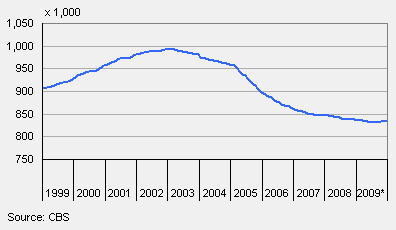Declining trend WAO benefits levels off

In the last quarter of 2009, the number of work disability benefits has risen marginally. For the first time in almost seven years, more work disability benefits were granted than terminated. At the end of last year, 834 thousand work disability benefits were granted.
Work disability benefits, 1999-2009

Four work disability schemes currently apply
Work disability benefits are granted on the basis of various schemes. Most benefits are based on the Industrial Disablement Act (WAO). No new WAO benefits have been granted since 2004. This also applies to benefits granted on the basis of the Disablement Act for Self-employed (WAZ). Current benefits are not affected. The number of WAO and WAZ benefits has shrunk by an average of 3.2 thousand a month in the past two years.
The Work and Income Capacity Act (WIA) was introduced on 1 January 2006 to replace the WAO. Lastly, there is the Income Provision Act for Young People (Wajong). Over the past two years, the amount of benefits granted on the basis of the WIA and Wajong schemes has grown by an average of 2.8 thousand a month. With 3.8 thousand, the monthly inflow of new WIA and Wajong benefit recipients in the fourth quarter of 2009 remained relatively high.
Work disability recipients by type of scheme, end of year

Number of WAO and WAZ benefits anticipated to drop by 200 thousand in the next five years
At the end of 2009, more than 200 thousand WAO and WAZ recipients were 60 years or older. When they turn 65, they will no longer receive these types of benefits. As a result, the number of WAO and WAZ benefits will be reduced by an average of more than 3.3 thousand a month over the next half decade.
Gender gap closing
By the end of 1999, 547 thousand work disability benefits were granted to men and 379 thousand to women. A decade later, the number of benefits to male recipients has dropped to 446 thousand and the number of benefits to female recipients has risen to 388 thousand. The female labour participation rate has also risen. By the end of last year, the participation rates for men and women on the labour market were 53 and 47 percent respectively. With 41 thousand, the number of WIA benefits granted to men and women was the same.
Work disability benefits by gender, end of year

Ton van Maanen